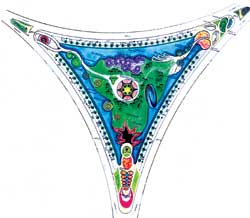 Do we always need a SAARC Summit or a big international brouhaha to make things happen in this city?
Do we always need a SAARC Summit or a big international brouhaha to make things happen in this city? Two years ago, the government decided that the squalid triangular intersection at Tinkune needed an urgent facelift so it would not be a national embarrassment before SAARC summiteers. So, within a fortnight it underwent a dramatic transformation: shanties were demolished and tea shops moved out. Overnight, a picturesque lake had sprung up in the 50-ropani plot with a rock garden, an island festooned with prayer flags and an impromptu pine grove.
The person who pulled off that miracle was Renchin Yonjon, a self-described "social architect and entrepreneur" working with the Kathmandu Municipality then. Unfortunately, after the summit ended everyone forgot about Tinkune again. The edges have now reverted into a garbage dump, the lake has become a wallow for water buffaloes and a convenient site for locals to carry on with their morning business.
Everyone tsk-tsks as they drive by, but Yonjan has remained committed to turning Tinkune into a symbolic peace park called the Basundhara Mother Earth Project. She is determined that this time, the upgrading will be permanent and maintained through a public-private partnership. Yonjan's plan for the triangle incorporates the five elements of earth, air, fire, water and space, and is purposely designed to resemble the female reproductive system, complete with fallopian tubes.
 Designed by architects and landscape artists, Basundhara's three entry points will symbolise Positive Energy, Peace and Wisdom. The garden for wisdom will face the airport road and will be dedicated to Manjushree and Saraswati. It will also have a pond that will represent the primordial lake that was once Kathmandu Valley. "It is time that the people of Kathmandu seriously started thinking of open spaces, my mission is to create a garden that will not just be an open space but also embody the symbols of peace and harmony that are so important for Nepal today," explains Yonjan.
Designed by architects and landscape artists, Basundhara's three entry points will symbolise Positive Energy, Peace and Wisdom. The garden for wisdom will face the airport road and will be dedicated to Manjushree and Saraswati. It will also have a pond that will represent the primordial lake that was once Kathmandu Valley. "It is time that the people of Kathmandu seriously started thinking of open spaces, my mission is to create a garden that will not just be an open space but also embody the symbols of peace and harmony that are so important for Nepal today," explains Yonjan. With funding from Eco Himal and inputs from young Nepali architecture graduates, Yonjan has now finalised her proposal which comes with a sustainability and management plan. It would cost only Rs 12 million to build, and she wants to start in January. She has pitched the idea to Kathmandu's mayor Keshab Sthapit, but hasn't heard from him.
The mayor, as it happens, has his own grandiose vision for Tinkune: a mega shopping mall with a 50ft figure of Manjushree at the centre. Sthapit says he is preparing a public hearing soon in which various plans will be presented to the local people of the area and to prospective private sector sponsors. "First we have to sort out the legal problems," Stapit told us. "The real reason for the delay is political, the locals were incited by politicians during the last elections not to take our offer of compensation for the land. That is why it is stuck."
The municipality doesn't want to pay more than Rs 3.2 million per ropani, and locals won't accept anything less than Rs 5.1 million. While the haggling goes on, Tinkune remains in limbo. "Governments have budgeted the amount, but never got anything," says 70-year-old Dharma Nath Gajurel, a landowner who is leading a legal battle for Tinkune. Gopal Gautam, another Tinkune land owner is an angry man: "Don't we have any rights at all? You can't just come and take away our land."
Mayor Sthapit says locals are just being greedy. "They should have taken the 30 lakhs when we offered it to them, after all their existing property has appreciated after the intersection was built." Until the legal battle over compensation is sorted out, it seems, Yonjan and her peace park plan will have to wait.


